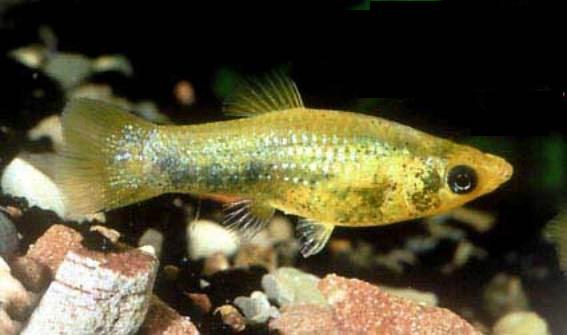Molly - Gold
24K Molly, 24 Carat Gold Molly Scientific Name: Poecilia sphenops
Sat, 19th April, 2025 - 2:27 pm GMT
Sponsor Ads:

Alternative Name
24K Molly, 24 Carat Gold Molly Scientific Name: Poecilia sphenopsBasic Info
Adult Gold Mollies often measure two and a half inches (six centimeters) in length. They are gold, as the name suggests. Female Gold Mollies have rounder bellies than their male counterparts. Their mouths are pointed and the fins of Gold Mollies are usually slightly rounded.
Health
Most Gold Mollies will thrive in temperatures between 62 and 82 degrees Fahrenheit (18 to 28 degrees Celsius). They can tolerate pH values between 7.5 and 8.2. A General Hardness between 11 and 30 is appropriate. Plenty of hiding places should be offered. Gold Mollies normally do well with other fish. Gold Mollies are fed zucchini, lettuce, and peas. Often live and frozen bloodworms, glass worms, and brine shrimp are also offered. Live tubifex worms and frozen daphnia, beef heart, plankton, and vegetable diet are offered. Freeze dried and flake foods are also offered to Gold Mollies. They may also graze on algae in their enclosures. Breeding Male Gold Mollies usually have longer, more pointed dorsal fins than do females. They can also be identified by their gonopodiums, mating structures that grow below their bodies, presumably developing out of their anal fins. Gold Mollies bear live young, often producing between 20 and 40 fry. Some Gold Mollies may eat their young.Habitat
Fresh water fish - The Gold Molly usually swims at all levels of an enclosure.Behavior
The hardy Gold Molly can make a great freshwater captive. Although it is fairly resilient, like many popular Mollies, its lovely gold color can make it a bit more exotic than the standard Black Molly. Some Gold Mollies show schooling behavior. They are best kept in a ratio of two females per male. These fish usually get along nicely with other fish in an enclosure. However, more aggressive fish may bully them. Gold Mollies may also assist in maintaining cleanliness by nibbling at algae in their aquarium.Origin
Central America and MexicoHistory
Gold Mollies are found in the wild from Mexico to Columbia. They are popular as pets due to their wonderful coloration and hardy natures.Common Foods
N/ASponsor Ads:
Nothing irritates a standard American corporate executive quite so much as the sight of someone actually daring to practice capitalism. -- Unknown
Molly - Gold
Coded by: BGID® | ALL RIGHTS RESERVED Copyright © 2000-2025
Disclaimer | Privacy | Report Errors / Contact | Credits








 President of the United States of America - Real Estate mogul, Pageant owner and now one of the most controversial men in political history.
President of the United States of America - Real Estate mogul, Pageant owner and now one of the most controversial men in political history.  Politician, US Vice President and President of the USA - Joseph Robinette Biden Jr.
Politician, US Vice President and President of the USA - Joseph Robinette Biden Jr.  versus
versus  Russia: 'The Evil Empire'? Are they all that bad or is it just the USA trying to portray Russia as bad because they are a world power with land bigger and a society very different from the USA ideal?
Russia: 'The Evil Empire'? Are they all that bad or is it just the USA trying to portray Russia as bad because they are a world power with land bigger and a society very different from the USA ideal?  Global warming has been in and out as the "latest" hot topic for many years. It is, according to modern scientists, the result of man-made industrial pollutants, clearing forested areas, agriculture, etc. But now they are thinking it started way before the Industrial Revolution...
Global warming has been in and out as the "latest" hot topic for many years. It is, according to modern scientists, the result of man-made industrial pollutants, clearing forested areas, agriculture, etc. But now they are thinking it started way before the Industrial Revolution... 
 Corona virus
Corona virus 
 Users with wide screen monitors can benefit from more content on every page.
Users with wide screen monitors can benefit from more content on every page.